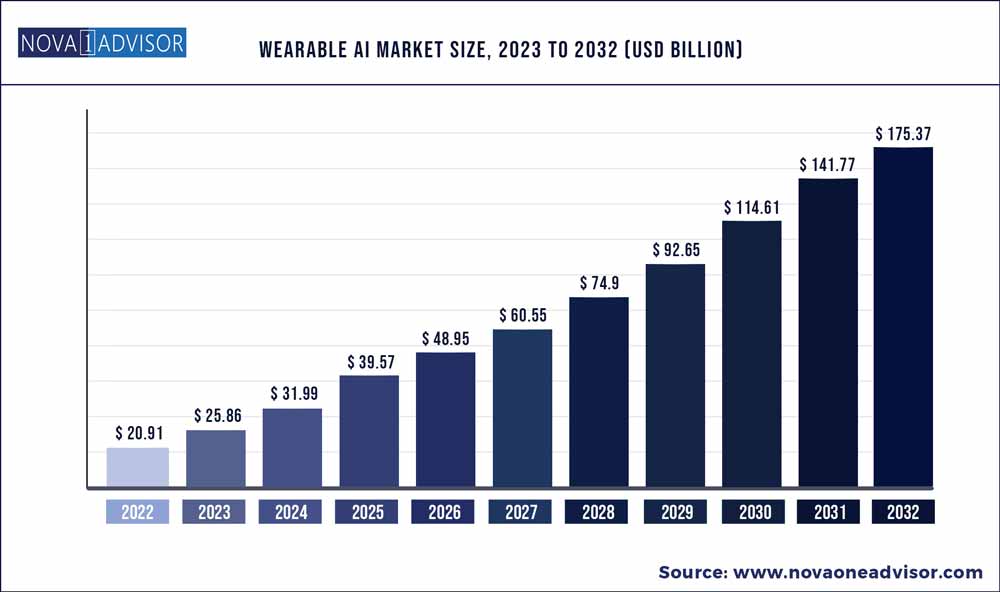The global wearable AI market size was exhibited at USD 20.91 billion in 2022 and is projected to hit around USD 175.37 billion by 2032, growing at a CAGR of 23.7% during the forecast period 2023 to 2032.

Key Pointers:
- The smartwatches segment accounted for the largest revenue share of over 31.19% in 2022.
- Smart earwear is expected to exhibit the fastest CAGR of 30.9% over the forecast period.
- The consumer electronics segment accounted for the largest revenue share of over 31.8% in 2022
- The on-device AI segment dominated the market with a share of over 56.4% in 2022
- The sensors segment dominated the market in 2022 with a revenue share of over 51.9%
- North America held the largest market share of 38.9% in terms of revenue in 2022
- Asia Pacific is expected to register the fastest growth rate over the forecast period .
The market is witnessing significant growth due to the exponential rise of emerging technologies, such as artificial intelligence (AI), and 5G smartphone adoption. The increased adoption of smart wearables enabled with AI is due to the advancement of IoT, integration of wireless technology, and the increasing popularity of smartwatches among millennials and Gen Z.
The continuous research and development by key players are driving the market in industry verticals, such as healthcare, automotive, media and entertainment, military and defense, and consumer electronics. For instance, in June 2020, Fitbit announced Fitbit Flow, in response to the lack of ventilators in hospitals and medical facilities around the world that are required to treat critically ill patients. The equipment is intended to serve as an alternative to more expensive traditional ventilators when they are not available.
Wearable AI devices are electronic products with advanced technologies incorporated with artificial intelligence with the ability to execute intelligent operations that are manufactured to be worn on the user’s body. The COVID-19 pandemic had a moderate impact on the market for wearable AI. The lockdown imposed in various countries had a negative impact on the supply chain and therefore the availability of products to the consumers. Additionally, the pandemic had a positive impact on the medical AI wearable segment.
The wearable technologies assisted in the COVID-19 pandemic and numerous wearable manufacturers started modifying their products to help with the early detection of COVID-19. Algorithms for measuring coughing and other respiratory activities were developed. This enabled less affected individuals to be monitored remotely, which eased the burden on hospitals. Many companies in the market focused on high investment in R&D for incorporating technologies in the wearables to track COVID-19. For instance, Masimo SafetyNet, a disposable fingertip attachment worn on a wearable bracelet, helped in tracking a patient's blood oxygen levels, breathing rate, and pulse both inside and outside of a hospital setting.
Based on regions, North America held the largest market share of 38.9% in terms of revenue in 2022 owing to heavy investment by private players and supportive government initiatives for the adoption of AI technology. In June 2020, Fitbit announced Fitbit Flow, a wearable AI device in response to the lack of ventilators in hospitals and medical facilities around the world that are required to treat critically ill patients. The equipment was intended to serve as an alternative to more expensive traditional ventilators when those are not an option. Similarly, in August 2020, Amazon announced the launch of its flagship fitness tracker the Halo in the U.S., Halo is a smart wearable fitness tracker that tracks mood through voice and scans the wearer's body to measure body fat and provides analysis for the same.
Asia Pacific is expected to register the fastest growth rate over the forecast period owing to collaborations, high investment by private players, and government initiatives for the use of AI wearables for contactless payments. For instance, in 2022, Monarch Technologies partnered with Canna Group LLC to launch Helox, a cashless contactless payment platform for the cannabis industry. It offers a hassle-free way of accepting payments.
Wearable AI Market Segmentation
| By Type |
By Application |
By Operations |
By Component |
|
Smartwatches
Smart Eyewear
Smart Earwear
Others
|
Consumer Electronics
Healthcare
Automotive
Military & Defense
Media & Entertainment
Others
|
On-device AI
Cloud-based AI
|
Processor
Connectivity IC
Sensors
|
Wearable AI Market Key Players And Regions
| Companies Profiled |
Regions Covered |
|
Amazon.com, Inc.
Fitbit, Inc.
Garmin Ltd.
Google, Inc.
Huawei Technologies Co. Ltd.
IBM
Motorola Solutions, Inc.
TomTom International B.V.
Apple, Inc.
Samsung Electronics Co. Ltd.
Sony Corporation
|
North America
Europe
Asia-Pacific
Latin America
Middle East & Africa (MEA)
|

